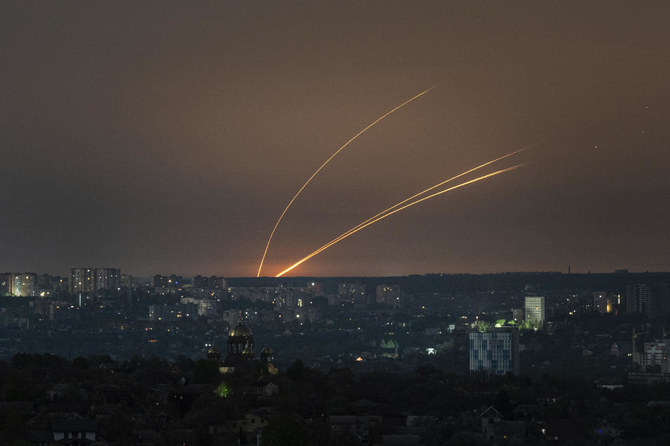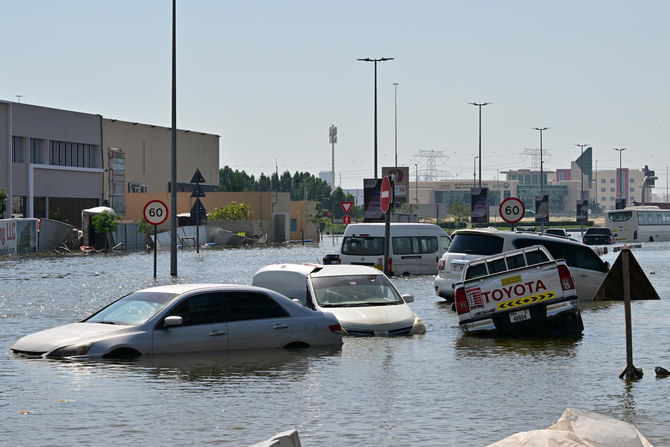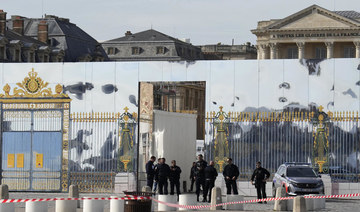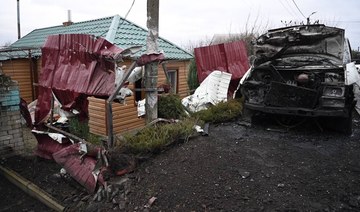WASHINGTON: From the inaugural platform, President Joe Biden saw American sickness on two fronts — a disease of the national spirit and the one from the rampaging coronavirus — and he saw hope, because leaders always must see that.
“End this uncivil war,” he implored Americans on Jan. 20, 2021. Of the pathogen, he said: “We can overcome this deadly virus.”
Neither malady has abated.
For Biden, it’s been a year of lofty ambitions grounded by the unrelenting pandemic, a tough hand in Congress, a harrowing end to a foreign war and rising fears for the future of democracy itself. Biden did score a public-works achievement for the ages. But America’s cracks go deeper than pavement.
In this midterm election year, Biden confronts seething divisions and a Republican Party that propagates the delusion that the 2020 election, validated as fair many times over, was stolen from Donald Trump. That central, mass lie of a rigged vote has become a pretext in state after state for changing election rules and fueling even further disunity and grievance.
In the dispiriting close of Biden’s first year, roadblocks stood in the way of all big things pending.
The Supreme Court blocked his vaccinate-or-test mandate for most large employers. Monthly payments to families that had slashed child poverty ran out Friday, with no assurance they will be renewed. Biden’s historic initiative to shore up the social safety net wallowed in Congress. And people under 40 have never seen inflation like this.
After his lacerating speech in Atlanta invoking the darkest days of segregation, he saw his voting-rights legislation run aground when Democratic Sen. Krysten Sinema of Arizona announced her opposition to changing Senate rules to allow the bill to pass by a simple majority.
Altering the rules would only “worsen the underlying disease of division infecting our country,” she said.
For all of that, Barack Obama was on to something when he paid his old vice president an odd compliment late in the 2020 campaign. Elect Joe Biden, he said, and after four years of flamboyant Trump dramas, folks could feel safe ignoring their president and vice president for a spell.
“You’re not going to have to think about them every single day,” Obama said. “It just won’t be so exhausting. You’ll be able to go about your lives.”
Indeed America saw normalcy, some say dignity, return to the White House. Pets came back and so did daily press briefings for the public.
The Trump-era political muzzle came off public-health authorities, freeing them to confuse the public all on their own.
First lady Jill Biden’s studded “Love” jacket at a global summit not-so-subtly countered the “I Really Don’t Care, Do U?” jacket her predecessor wore in a visit to a migrant child detention center.
The discipline, drive and baseline competence from the new White House produced notable results. Biden won a bipartisan infrastructure package that had eluded his two predecessors, coming away with a legacy-shaping fix for the rickety pillars of industry and society.
Biden steered more judges through Congress to the federal bench than any recent predecessor. He won approval of a Cabinet that was half women and a minority of white people for the first time. More than 6 million people are back at work and half a billion COVID-19 vaccines have been put in arms, but the nation has a long way to go to return to its pre-pandemic state.
“I think it’s a lot of achievements, a lot of accomplishment, in the face of some very serious obstacles,” Biden’s chief of staff, Ron Klain, told The Associated Press on the cusp of Biden’s second year. “The Biden presidency remains a work in progress.”
Matthew Delmont, a civil rights historian at Dartmouth, expected more from Biden by virtue of his decades of experience as a savvy operator in the capital.
He had anticipated a far more effective COVID-19 response and more urgency, sooner, in countering the rollback of voting rights and tilting of election rules that Republicans are attempting.
“There’s something to be said for the professionalism of the White House and not going from one fire to the next,” Delmont said. “What I worry is that the Washington he understands isn’t the Washington we have anymore.”
Political science professor Cal Jillson at Southern Methodist University in Dallas said Biden has displayed “warning track power” — the ability in baseball to hit long but not, as yet, over the fence.
In Biden, Jillson sees a leader who brought the even keel that Obama had talked about but also one who only rarely delivers a speech worth remembering.
“While there are vast partisan differences in how Biden is seen, in general he is seen as stable but not forceful,” he said.
In large measure, Biden’s innate civility and predictability brought the sort of climate change that the world could get behind.
Here once more was a president who believed deeply in alliances and vowed to repair an American reputation frayed by the provocateur in office before him.
There would be no more puzzling feelers about buying Greenland. No more doting looks at Russian President Vladimir Putin — instead, Biden stepped up diplomatic confrontation over Putin’s designs on Ukraine. There would be no eerie uplit gatherings around glowing orbs with rulers of dissent-crushing Arab countries like Trump’s photo op with the Saudis.
But the world also witnessed Biden’s debacle in Afghanistan, a chaotic withdrawal that brought more than 124,000 to safety but stranded thousands of desperate Afghans who had been loyal to the US and hundreds of US citizens and green-card holders.
Discounting warnings from military and diplomatic advisers, Biden misjudged the Taliban’s tenacity and the staying power of Afghan security forces that had seen crucial US military support vanish. He then blamed Afghans for all that went wrong. Millions of Afghans face the threat of famine in the first winter following the Taliban takeover.
All presidents enter the world’s most powerful office buoyed by their victory only to confront its limitations in time. For Biden, that happened sooner than for most. A polarized public, Trump’s impeachment trial and an evenly divided Senate saw to that.
Meantime, day after day, event after event, it was the virus that commanded Biden’s attention. “That challenge casts a shadow over everything we do,” Klain said. “I think we’ve made historic progress there but it’s still a challenge.”
After Biden’s first year, the virus and disunity rage on
https://arab.news/pu6x4
After Biden’s first year, the virus and disunity rage on

- The Trump-era political muzzle came off public-health authorities, freeing them to confuse the public all on their own
Man arrested after Denmark’s Billund Airport evacuated over bomb threat

- Investigations into the incident are continuing, the police said
COPENHAGEN: A man was arrested in Denmark on Saturday in connection with a bomb threat at Billund Airport, the country’s second largest aviation hub, police said in a statement.
The airport, in central western Denmark, was evacuated and remains shut following the threat.
“The evacuation has proceeded calmly and as expected, with travelers following our instructions,” police inspector Michael Weiss said in a statement.
Investigations into the incident are continuing, the police said, adding it was not clear when the airport would reopen.
Indonesia on highest alert as Sulawesi volcano continues to erupt

- Over 7,500 people living near the volcano have so far been evacuated
- Volcanic activity is common in Indonesia, which lies on the Pacific ‘Ring of Fire’
JAKARTA: Indonesian authorities were on the highest alert on Saturday as a volcano in North Sulawesi continued to erupt. Thousands living nearby have been forced to leave their homes.
Mount Ruang, located on the northern side of Sulawesi Island, had at least eight eruptions since April 16, including a major one on Wednesday evening, which prompted Indonesia’s volcanology agency to issue its highest alert, which indicates an active eruption.
The center recorded at least two eruptions on Saturday, with the crater emitting white-gray smoke more than 1,200 meters above its peak after midnight, followed by another eruption at noon that released an ash column of about 250 meters.
“Based on visual observations, as of April 20, 2024, at 12:15 p.m., there is still high volcanic activity in Mt. Ruang,” Muhammad Wafid, head of the geology department at the Ministry of Energy and Mineral Resources, said in a statement.
“The potential danger is an explosive eruption that may cause the mountain to spew volcanic rocks in different directions, followed by clouds, as well as effusive eruption, or lava flow.”
With authorities having established a six-kilometer exclusion zone around the volcano, around 7,500 people have so far been evacuated, including more than 1,500 residents who live on the smaller island where Mount Ruang stands, and around 6,000 people living on neighboring Tagulandang island, northeast of the volcano, according to the latest data from Indonesia’s National Disaster Mitigation Agency. Thousands more are still at risk.
The international airport in Manado city, less than 100 kilometers away from Mount Ruang, is closed until at least Sunday because of volcanic ash.
“There are still concerns, because tremors and volcanic earthquakes are still being recorded by our devices, indicating magmatic fluid supply is still moving from the depth to the surface,” Hendra Gunawan, who heads Indonesia’s volcanology agency, told Arab News.
“There’s still potential for more eruptions … And a tsunami may occur if there is a large flow of volcanic material into the sea.”
Indonesia, a vast archipelago nation, has around 120 active volcanoes. The country experiences frequent seismic and volcanic activity due to its location on the arc of volcanoes and fault lines in the Pacific Basin known as the “Ring of Fire.”
Moscow says 50 Ukrainian drones shot down as attacks spark fires at Russian power stations

- Fifty drones were shot down by air defenses over eight Russian regions, including 26 over the country’s western Belgorod region
- Russia’s Defense Ministry said that it had shot down a Ukrainian Sukhoi Su-25 fighter jet
KYIV: Ukraine launched a barrage of drones across Russia overnight, the Defense Ministry in Moscow said Saturday, in attacks that appeared to target the country’s energy infrastructure.
Fifty drones were shot down by air defenses over eight Russian regions, including 26 over the country’s western Belgorod region close to the Ukrainian border. Two people — a woman with a broken leg and the man caring for her — died during the overnight barrage, after explosions sparked a blaze that set their home alight, Belgorod Gov. Vyacheslav Gladkov wrote on social media. A pregnant woman and her unborn child were also killed in shelling later Saturday, he said.
Drones were also reportedly destroyed over the Bryansk, Kursk, Tula, Smolensk, Ryazan, Kaluga regions across Russia’s west and south, as well as in the Moscow region.
Russia’s Defense Ministry said that it had shot down a Ukrainian Sukhoi Su-25 fighter jet. It provided no details and the claims could not be independently verified.
Ukrainian officials normally decline to comment about attacks on Russian soil. However, many of the drone strikes appeared to be directed toward Russia’s energy infrastructure.
The head of the Kaluga region, Vladislav Shapsha, said Saturday that a drone strike had sparked a blaze at an electrical substation, while Bryansk Gov. Alexander Bogomaz and Smolensk Gov. Vasily Anokhin also reported fires at fuel and energy complexes.
In recent months, Russian refineries and oil terminals have become priority targets of Ukrainian drone attacks, part of stepped-up assaults on Russian territory.
Ukrainian drone developers have been extending the weapons’ range for months, as Kyiv attempts to compensate for its battlefield disadvantage in weapons and troops. The unmanned aerial vehicles are also an affordable option while Ukraine waits for more US military aid.
Moscow also said Friday evening that an American citizen known to have fought with Kremlin-backed separatists in Ukraine between 2014 and 2017 had died in the Russian-occupied Donetsk region.
Russell Bentley, 64, was no longer involved in military operations and previously worked for state-owned Russian news agency Sputnik. His death was confirmed by his former battalion and by Margarita Simonyan, head of the state-funded television channel RT, who described him as “a real American.” He used the call-sign “Texas” and had spent time in prison on charges of drug smuggling before leaving the United States.
No information has been released as to the cause of Bentley’s death, but local police had previously reported the American as missing on April 8.
Meanwhile, Russia attacked Ukraine overnight with seven missiles, and air defenses downed two missiles and three reconnaissance drones, the Ukrainian air force said Saturday.
Gov. Oleh Kiper, head of Ukraine’s Odesa region, said that ballistic missiles had damaged infrastructure overnight, but did not provide further details. Previous attacks on the Black Sea city on Friday damaged port infrastructure, including two food export terminals, Ukrainian President Volodymyr Zelensky said.
Russian shelling also killed two men, including an 81-year-old pensioner in the city of Vovchansk, said Gov. Oleh Syniehubov, head of Ukraine’s Kharkiv region.
A 60-year-old woman was also injured after shelling struck a nine-story apartment block, he said.
Efforts underway to bring home Filipinos killed in UAE floods

- At least three Filipinos lost their lives in the unprecedented flooding
- Philippine consulate received assistance requests from at least 100 Filipinos
Manila: The Philippine government is assisting Filipinos affected by the record-high rains and flooding that hit the UAE this week, authorities said on Saturday, as it works to repatriate the nationals who lost their lives.
A strong storm first hit Oman last weekend, killing at least 20 people, before it pounded the UAE on Tuesday, marking the heaviest rains in 75 years and bringing the Gulf state to a standstill.
The Philippine Department of Migrant Workers has confirmed the deaths of at least three Filipinos who died in road accidents as their vehicles were submerged in floodwaters.
Philippine Consul General Marford Angeles told Arab News the consulate had received assistance requests from at least 100 Filipinos — some working in the UAE, some studying, and some transiting via Dubai.
“Over 1 million Filipino nationals are currently residing in the UAE ... Majority of assistance requests received by the consulate so far originate from the populous emirates of Dubai and Sharjah, reflecting the concentration of Filipino residents in these areas,” he said.
“The unprecedented weather conditions in the UAE affected most residents.”
The three Filipinos who lost their lives in the floods were two women who died inside their flooded vehicle, and a man who died after sustaining major injuries when his vehicle fell into a sinkhole. His two passengers have been hospitalized.
“The Department of Migrant Workers, through its Migrant Workers Offices in Dubai and Abu Dhabi, is working with local authorities for the repatriation of the remains of three overseas Filipino workers (OFWs) who died during the severe flooding,” the DMW said in a statement.
“Two other OFWs, both male, suffered injuries from the vehicular accident that happened in the sinkhole. They are recuperating from their injuries.”
US House to vote on long-awaited $95 billion Ukraine, Israel aid package

- Some hard-line Republicans have voiced strong opposition to further Ukraine aid
WASHINGTON: The Republican-controlled US House of Representatives on Saturday is set to vote on, and expected to pass, a $95 billion legislative package providing security assistance to Ukraine, Israel and Taiwan, over bitter objections from party hard-liners.
More than two months have passed since the Democratic-majority Senate passed a similar measure and US leaders from Democratic President Joe Biden to top Senate Republican Mitch McConnell have been urging embattled House Speaker Mike Johnson to bring it up for a vote.
Johnson this week chose to ignore ouster threats by hard-line members of his fractious 218-213 majority and push forward the measure that includes some $60.84 billion for Ukraine as it struggles to fight off a two-year Russian invasion.
The unusual four-bill package also includes funds for Israel, security assistance for Taiwan and allies in the Indo-Pacific and a measure that includes sanctions, a threat to ban the Chinese-owned social media app TikTok and the potential transfer of seized Russian assets to Ukraine.
“The world is watching what the Congress does,” the White House said in a statement on Friday. “Passing this legislation would send a powerful message about the strength of American leadership at a pivotal moment. The Administration urges both chambers of the Congress to quickly send this supplemental funding package to the President’s desk.”
A bipartisan 316-94 House majority on Friday voted to advance the bill to a vote, and Senate Majority Leader Chuck Schumer told senators to be ready to work over the weekend if it passes the House as expected.
“It’s not the perfect legislation, it’s not the legislation that we would write if Republicans were in charge of both the House, the Senate, and the White House,” Johnson told reporters on Friday. “This is the best possible product that we can get under these circumstances to take care of these really important obligations.”
Some hard-line Republicans have voiced strong opposition to further Ukraine aid, with some arguing the US can ill afford it given its rising $34 trillion national debt. They have repeatedly raised the threat of ousting Johnson, who became speaker in October after his predecessor, Kevin McCarthy, was ousted by party hard-liners.
Representative Bob Good, chair of the hard-line House Freedom Caucus, told reporters on Friday that the bills represent a “slide down into the abyss of greater fiscal crisis and America-last policies that reflect Biden and Schumer and (House Democratic leader Hakeem) Jeffries, and don’t reflect the American people.”
But Republican presidential candidate Donald Trump, who carries huge influence in the party, on April 12 voiced support for Johnson and in a Thursday social media post said Ukraine’s survival is important for the US
The bills provide $60.84 billion to address the conflict in Ukraine, including $23 billion to replenish US weapons, stocks and facilities; $26 billion for Israel, including $9.1 billion for humanitarian needs, and $8.12 billion for the Indo-Pacific.






















